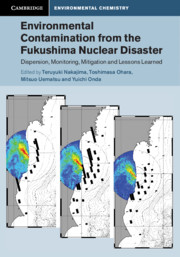 Environmental Contamination from the Fukushima Nuclear Disaster
Environmental Contamination from the Fukushima Nuclear Disaster Published online by Cambridge University Press: 16 August 2019
The accident of the Fukushima Daiichi (First) Nuclear Power Station (FDNPS) of the Tokyo Electric Power Company (hereafter, Fukushima accident) transpired after the Tohoku Region Pacific Coast Earthquake occurred in March 2011. Table 1.1 summarises the main events of the accident. After the earthquake occurred at 14:46 on 11 March 2011, tsunami waves of 13 m in height arrived at the FDNPS (TEPCO, 2011); the diesel power engine stopped at 15:41. Due to this electricity loss, the nuclear reaction became uncontrollable. The Fukushima Daini (Second) Power Station was able to make a controlled stop for cooling even after the intrusion of seawater from a tsunami wave with a height of 9 m. The estimated maximum height in the design of the Daiichi and Daini Power Stations was 5.1 m. In contrast, the estimated maximum tsunami height in the design of the Onagawa Nuclear Power Station of the Tohoku Electric Power Company, which avoided serious damage, was 14.8 m (Matsumoto, 2007).
To save this book to your Kindle, first ensure [email protected] is added to your Approved Personal Document E-mail List under your Personal Document Settings on the Manage Your Content and Devices page of your Amazon account. Then enter the ‘name’ part of your Kindle email address below. Find out more about saving to your Kindle.
Note you can select to save to either the @free.kindle.com or @kindle.com variations. ‘@free.kindle.com’ emails are free but can only be saved to your device when it is connected to wi-fi. ‘@kindle.com’ emails can be delivered even when you are not connected to wi-fi, but note that service fees apply.
Find out more about the Kindle Personal Document Service.
To save content items to your account, please confirm that you agree to abide by our usage policies. If this is the first time you use this feature, you will be asked to authorise Cambridge Core to connect with your account. Find out more about saving content to Dropbox.
To save content items to your account, please confirm that you agree to abide by our usage policies. If this is the first time you use this feature, you will be asked to authorise Cambridge Core to connect with your account. Find out more about saving content to Google Drive.